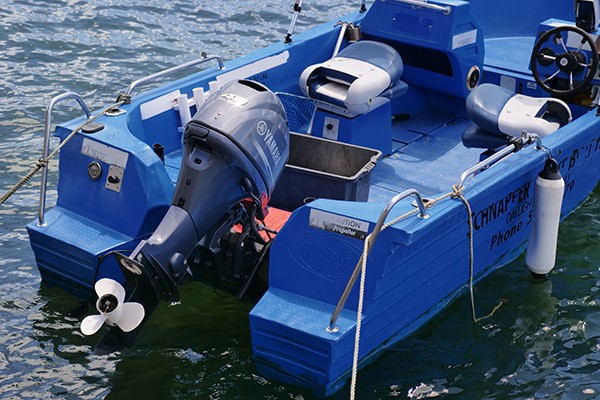
DON’T FORGET TO FLUSH
Back in the day, flushing an outboard with fresh water was done only one way. A set of “ear muffs” or “flush muffs” was fitted around the engine’s gear case to cover the water intakes, connected to a garden hose with a good water supply, and the engine was run for five to 10 minutes
Why
Salt and brackish water is a corrosive killer of the aluminum from which outboards are made, so flushing every time after saltwater use is a must. Left unchecked inside the cooling passages, saltwater will quickly build up and may cause cooling blockages, leading to overheating and, over time, can corrode an engine from inside out. All outboard manufacturers recommend flushing (according to the procedures outlined in the engine owner’s manual) after every use in salt, brackish, dirty, or polluted waters. Operating an engine in sandy, silty, or muddy fresh water also dictates the need for periodic flushing.
The Old-School Way
Flush muffs are the most common way to flush an outboard; they’re available at most marine stores and online resellers. They’re inexpensive, and easy to use. Connect to a garden hose, fit the muffs over the engine’s water intakes on the sides of the gear case, turn the water on, start the engine, and let it run. That’s it, with the following precautions:
- If your engine has additional water intakes that are not being directly fed water via the flushing muffs, they must be sealed off with a bit of duct tape, or overheating may occur.
- If your engine doesn’t have water intakes on the sides of the gear case, you will need a special type of flushing attachment that covers the front of the gear case. These can be purchased from aftermarket shops.
- When attaching the muffs, be sure they cover the water inlets completely and don’t pop or slide off when the water is turned on.
- Be vigilant, and don’t leave the engine while flushing. Watch the engine’s “tell-tale” overboard water indicator to ensure that the engine is pumping water.
- The engine should be kept in neutral and not run above a fast idle speed (1,000 rpm maximum).